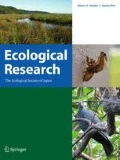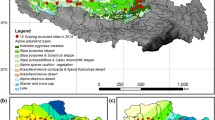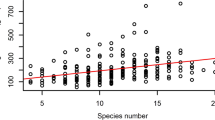Abstract
Here we report from a experiment imposing different warming scenarios [control with ambient temperature, constant level of moderate warming for 3 years, stepwise increase in warming for 3 years, and one season of high level warming (pulse) simulating an extreme summer event] on an alpine ecosystem to study the impact on species diversity–biomass relationship, and community resistance in terms of biomass production. Multiple linear mixed models indicate that experimental years had stronger influence on biomass than warming scenarios and species diversity. Species diversity and biomass had almost humpback relationships under different warming scenarios over different experimental years. There was generally a negative diversity–biomass relationship, implying that a positive diversity–biomass relationship was not the case. The application of different warming scenarios did not change this tendency. The change in community resistance to all warming scenarios was generally negatively correlated with increasing species diversity, the strength of the correlation varying both between treatments and between years within treatments. The strong effect of experimental years was consistent with the notion that niche complementarity effects increase over time, and hence, higher biomass productivity over experimental years. The strongest negative relationship was found in the first year of the pulse treatment, indicating that the community had weak resistance to an extreme event of one season of abnormally warm climate. Biomass production started recovering during the two subsequent years. Contrasting biomass-related resistance emerged in the different treatments, indicating that micro sites within the same plant community may differ in their resistance to different warming scenarios.





Similar content being viewed by others
References
Alatalo JM, Jägerbrand AK, Molau U (2015) Testing reliability of short-term responses to predict longer-term responses of bryophytes and lichens to environmental change. Ecol Indic 58:77–85. doi:10.1016/j.ecolind.2015.05.050
Alatalo JM, Jägerbrand AK, Molau U (2014a) Climate change and climatic events: community-, functional- and species-level responses of bryophytes and lichens to constant, stepwise, and pulse experimental warming in an alpine tundra. Alp Bot 124:81–91. doi:10.1007/s00035-014-0133-z
Alatalo JM, Jägerbrand AK, Molau U (2016) Impacts of different climate change regimes and extreme climatic events on an alpine meadow community. Sci Rep 6:21720. doi:10.1038/srep21720
Alatalo JM, Little CJ (2014) Simulated global change: contrasting short and medium term growth and reproductive responses of a common alpine/Arctic cushion plant to experimental warming and nutrient enhancement. SpringerPlus 3:157. doi:10.1186/2193-1801-3-157
Alatalo JM, Little CJ, Jägerbrand AK, Molau U (2014b) Dominance hierarchies, diversity and species richness of vascular plants in an alpine meadow: contrasting short and medium term responses to simulated global change. PeerJ 2:e406. doi:10.7717/peerj.406
Ali A, Yan E-R, Chen HY et al (2016) Stand structural diversity rather than species diversity enhances aboveground carbon storage in secondary subtropical forests in Eastern China. Biogeosciences 13:4627–4635
Arft AM, Walker MDM, Gurevitch J et al (1999) Responses of tundra plants to experimental warming: meta-analysis of the international tundra experiment. Ecol Monogr 69:491–511
Barton K (2016) MuMIn: Multi-Model Inference. R package version 1.15.6, pp. Model selection and model averaging based on information criteria (AICc and alike)
Bates D, Mächler M, Bolker B, Walker S (2015) Fitting linear mixed-effects models using lme4. J Stat Softw 67:1–48. doi:10.18637/jss.v067.i01
Bret-Harte MS, García EA, Sacré VM et al (2004) Plant and soil responses to neighbour removal and fertilization in Alaskan tussock tundra. J Ecol 92:635–647
Carlyle CN, Fraser LH, Turkington R (2013) Response of grassland biomass production to simulated climate change and clipping along an elevation gradient. Oecologia. doi:10.1007/s00442-013-2833-2
Domènech M, Komac B, Peñuelas J, Conesa JA (2014) Site-specific factors influence the richness and phenology of snowbed plants in the Pyrenees. Plant Biosyst Int J Deal Asp Plant Biol:1–9
Grime JP (1973) Competitive exclusion in herbaceous vegetation. Nat UK 242:344–347
Harms KE, Wright SJ, Calderón O et al (2000) Pervasive density-dependent recruitment enhances seedling diversity in a tropical forest. Nature 404:493–495
Hooper DU, Chapin FS, Ewel JJ et al (2005) Effect of biodiversity on ecosystem functioning: a consensus of current knowledge. Ecol Monogr 75:3–35. doi:10.1890/04-0922
Huston MA (1997) Hidden treatments in ecological experiments: re-evaluating the ecosystem function of biodiversity. Oecologia 110:449–460
IPCC (2014) Climate change 2014: impacts, adaptation and vulnerability. Contribution of Working Group II to the Fifth Assessment Report of the IPCC. Cambridge University Press, Cambridge
IPCC (2007) Climate change 2007: impacts, adaptation and vulnerability: Working Group II Contribution to the Fourth Assessment Report of the IPCC Intergovernmental Panel on Climate Change. Cambridge
Jonasson S, Michelsen A, Schmidt I, Nielsen E (1999) Responses in microbes and plants to changed temperature, nutrient, and light regimes in the arctic. Ecology 80:1828–1843
Karlsson U (1998) Evaluation of pointframe cover assessment for estimating biomass in alpine tundra. B.Sc. Thesis, University of Gothenburg
Klanderud K, Totland Ø (2008) Diversity-stability relationships of an alpine plant community under simulated environmental change. Arct Antarct Alp Res 40:679–684. doi:10.1657/1523-0430(07-075)
Klanderud K, Totland Ø (2005) Simulated climate change altered dominance hierarchies and diversity of an alpine biodiversity hotspot. Ecology 86:2047–2054
Klaus VH, Hölzel N, Boch S et al (2013) Direct and indirect associations between plant species richness and productivity in grasslands: regional differences preclude simple generalization of productivity-biodiversity relationships. Preslia 85:97–112
Kravtsova VI, Loshkareva AR (2013) Dynamics of vegetation in the tundra-taiga ecotone on the Kola Peninsula depending on climate fluctuations. Russ J Ecol 44:303–311. doi:10.1134/S1067413613040085
Lohbeck M, Poorter L, Martínez-Ramos M, Bongers F (2015) Biomass is the main driver of changes in ecosystem process rates during tropical forest succession. Ecology 96:1242–1252
Loreau M (2000) Biodiversity and ecosystem functioning: recent theoretical advances. Oikos 91:3–17
Loreau M (1998) Biodiversity and ecosystem functioning: a mechanistic model. Proc Natl Acad Sci 95:5632–5636
Magurran AE (2013) Measuring biological diversity. Wiley, Oxford
Marchand FL, Kockelbergh F, Van de Vijver B et al (2006a) Are heat and cold resistance of arctic species affected by successive extreme temperature events? New Phytol 170:291–300
Marchand FL, Mertens S, Kockelbergh F et al (2005) Performance of High Arctic tundra plants improved during but deteriorated after exposure to a simulated extreme temperature event. Glob Change Biol 11:2078–2089
Marchand FL, Verlinden M, Kockelbergh F et al (2006b) Disentangling effects of an experimentally imposed extreme temperature event and naturally associated desiccation on Arctic tundra. Funct Ecol 20:917–928. doi:10.1111/j.1365-2435.2006.01203.x
Marion G, Henry GHR, Freckrnan DW et al (1997) Open-top designs for manipulating field temperature in high-latitude ecosystems. Glob Change Biol 3:20–32
May JL, Hollister RD (2012) Validation of a simplified point frame method to detect change in tundra vegetation. Polar Biol 35:1815–1823. doi:10.1007/s00300-012-1224-1
Mittelbach GG, Steiner CF, Scheiner SM et al (2001) What is the observed relationship between species richness and productivity? Ecology 82:2381–2396
Molau U (2010) Long-term impacts of observed and induced climate change on tussock tundra near its southern limit in northern Sweden. Plant Ecol Divers 3:29–34. doi:10.1080/17550874.2010.487548
Mulder CPH, Uliassi DD, Doak DF (2001) Physical stress and diversity-productivity relationships: the role of positive interactions. Proc Natl Acad Sci 98:6704–6708
Nakagawa S, Schielzeth H (2013) A general and simple method for obtaining R2 from generalized linear mixed-effects models. Methods Ecol Evol 4:133–142
Oksanen J, Guillaume Blanchet, F Kindt R, Legendre P et al (2013) Community Ecology Package, Package “vegan.”
Opedal ØH, Armbruster WS, Graae BJ (2014) Linking small-scale topography with microclimate, plant species diversity and intra-specific trait variation in an alpine landscape. Plant Ecol Divers:1–11
Pfisterer AB, Schmid B (2002) Diversity-dependent production can decrease the stability of ecosystem functioning. Nature 416:84–86
Pimm SL (1984) The complexity and stability of ecosystems. Nature 307:321–326
Poldini L, Sburlino G, Buffa G, Vidali M (2011) Correlations among biodiversity, biomass and other plant community parameters using the phytosociological approach: a case study from the south-eastern Alps. Plant Biosyst Int J Deal Asp Plant Biol 145:131–140. doi:10.1080/11263504.2010.547673
Press M, Potter J, Burke M et al (1998) Responses of a subarctic dwarf shrub heath community to simulated environmental change. J Ecol 86:315–327. doi:10.1046/j.1365-2745.1998.00261.x
R Core Team (2015) R: a language and environment for statistical computing. R Foundation for Statistical Computing, Vienna
Sun J, Li XZ, Wang XW et al (2011) Latitudinal pattern in species diversity and its response to global warming in permafrost wetlands in the Great Hing’an Mountains, China. Russ J Ecol 42:123–132. doi:10.1134/S1067413611020111
Tilman D (1996) Biodiversity: population versus ecosystem stability. Ecology 77:350–363
Underwood A (1994) On beyond BACI: sampling designs that might reliably detect environmental disturbances. Ecol Appl 4:3–15
Virtanen R, Grytnes J-A, Lenoir J et al (2013) Productivity–diversity patterns in arctic tundra vegetation. Ecography 36:331–341. doi:10.1111/j.1600-0587.2012.07903.x
Walker BH (1992) Biodiversity and ecological redundancy. Conserv Biol 6:18–23
Wang Y, Yu S, Wang J (2007) Biomass-dependent susceptibility to drought in experimental grassland communities. Ecol Lett 10:401–410
Wilsey BJ, Potvin C (2000) Biodiversity and ecosystem functioning: importance of species evenness in an old field. Ecology 81:887–892
Wu X, Lin X, Zhang Y et al (2014) Impacts of climate change on ecosystem in priority areas of biodiversity conservation in China. Chin Sci Bull 59:4668–4680. doi:10.1007/s11434-014-0612-z
Yachi S, Loreau M (1999) Biodiversity and ecosystem productivity in a fluctuating environment: the insurance hypothesis. Proc Natl Acad Sci 96:1463–1468
Zhang Y, Chen HY (2015) Individual size inequality links forest diversity and above-ground biomass. J Ecol 103:1245–1252
Zhang Y, Wang Y, Zhang M, Ma K (2014) Climate change threats to protected plants of China: an evaluation based on species distribution modeling. Chin Sci Bull 59:4652–4659. doi:10.1007/s11434-014-0642-6
Zhao J, Liu W, Ye R et al (2013) Responses of reproduction and important value of dominant plant species in different plant functional type in Kobresia meadow to temperature increase. Russ J Ecol 44:484–491. doi:10.1134/S1067413613060131
Zuur AF, Ieno EN, Walker N et al (2009) Mixed effects models and extensions in ecology with R. Springer, New York
Acknowledgments
We thank the staff of Abisko Scientific Research Station for help and hospitality and Vivian Aldén, Björn Aldén and Olga Khitun for assistance in the field. This study was supported by an NFR Grant (B-AA/BU 08424) to Professor Ulf Molau. Constructive comments from two anonymous reviewers helped to substantially improve an earlier version of this manuscript.
Author information
Authors and Affiliations
Corresponding author
About this article
Cite this article
Ali, A., Molau, U., Bai, Y. et al. Diversity-productivity dependent resistance of an alpine plant community to different climate change scenarios. Ecol Res 31, 935–945 (2016). https://doi.org/10.1007/s11284-016-1403-6
Received:
Accepted:
Published:
Issue Date:
DOI: https://doi.org/10.1007/s11284-016-1403-6




